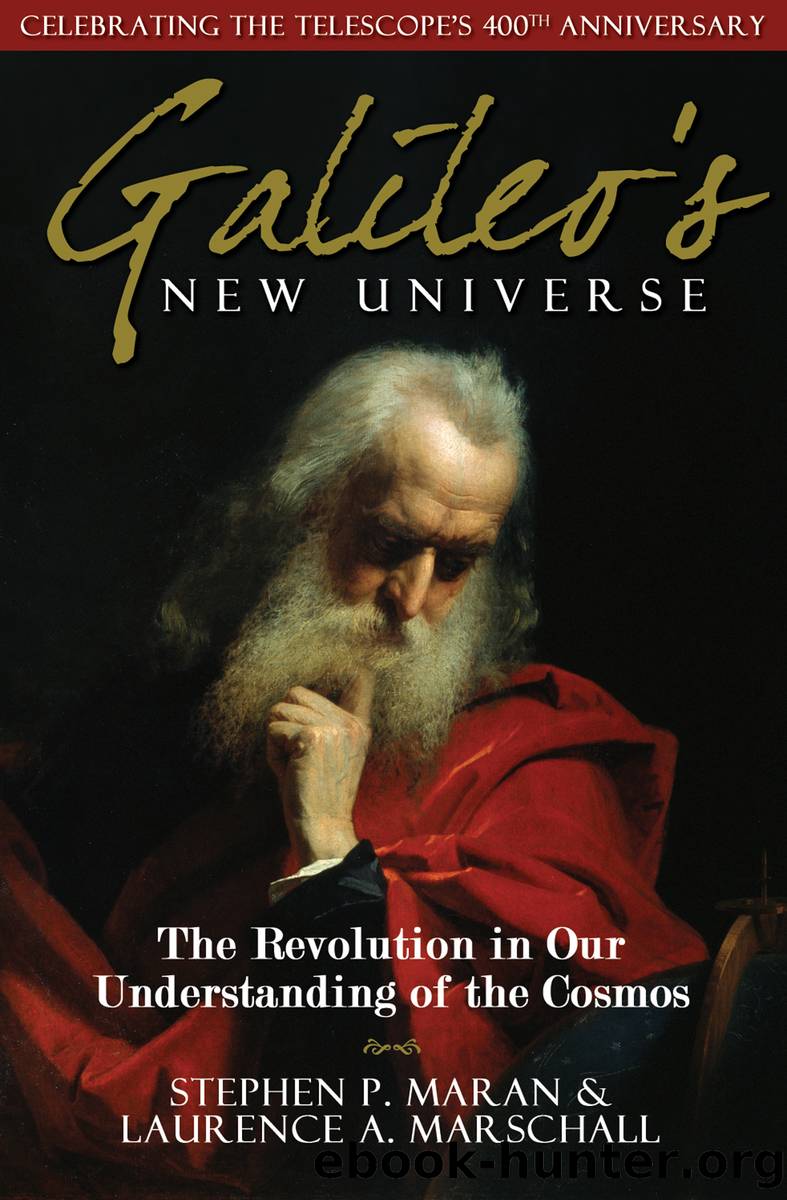Galileo's New Universe by Maran Stephen P.; Marschall Laurence A.;

Author:Maran, Stephen P.; Marschall, Laurence A.;
Language: eng
Format: epub
Publisher: BenBella Books
Published: 2019-07-11T16:16:46+00:00
* * *
8 Van Helden, Albert. âSaturn and His Anses.â Journal for the History of Astronomy. Volume 5, 1974. 105.
9 Galilei, Galileo. âLetters on Sunspots.â In Drakeâs Discoveries and Opinions of Galileo. 143â144.
Chapter 7
Venus
Venus in the Seventeenth Century
When Galileo first observed the planets in the fall of 1609, Venus was visible only in the early morning sky. Apparently Galileo was not an early riser, since he did not turn his telescope on Venus until the following autumn, when he could see it, conveniently, in the evening. But surely he must have eagerly anticipated what that first glimpse of Venus would reveal. Venus is the mother of the planets: it outshines everything in the sky except for the Sun and the Moon, so brightly, in fact, that on moonless nights it casts faint shadows on the ground. Though you may not have recognized it, you have probably seen Venus many times, for it is often the first object to catch oneâs eye at night. When it is east of the Sun, we call it the âevening star,â stark and brilliant against the indigo twilight, and when it is west of the Sun, it is the âmorning star,â shining brightly in the gathering glow of dawn. If you know where to look, you can even see it in the bright blue of the daytime sky.
Ancient astronomers venerated Venus, perhaps thinking it drew its brilliance from some inner vital force. She was Ishtar to the Babylonians, both a mother deity and a goddess of war, and to the Greeks she was Aphrodite, the goddess of love. To academic scholars in the time of Galileo, Venus was one of the seven planets described by Aristotle, presumably traveling through the heavens somewhere between Mercury and the Sun.
Venus is distinguished not only by its brightness, but also by the fact that it always appears close to the Sun in the sky. Depending on the year and the season, Jupiter and Saturn can be found anywhere along the ecliptic (the Sunâs path in the sky). They can be seen near the Sun at dusk and dawn, or opposite the Sun, high in the sky at midnight. Venus, however, is never visible at midnight. It is always within about 45 degrees of the Sun and so is only seen within a few hours of sunset or sunrise. As the Sun moves around the sky during the year, Venus travels sometimes to its east and sometimes to its west, always reversing its direction before it gets too far from the Sun. It is like the puppy of the Sun god, bound to its master by an invisible leash.
Galileo would have learned in school that Venus traveled around the Earth, for Aristotle had written that everything in the heavens traveled in perfect circles with the Earth at the center. But astronomers struggled for centuries to reconcile the actual behavior of Venus with Aristotleâs dictum of circular motion. If Venus went around the Earth, why did it reverse
Download
This site does not store any files on its server. We only index and link to content provided by other sites. Please contact the content providers to delete copyright contents if any and email us, we'll remove relevant links or contents immediately.
Invention by James Dyson(725)
Thinking Better by Marcus du Sautoy(683)
The Ten Equations That Rule the World by David Sumpter(674)
Concepts of Space by Jammer Max;(656)
God and the Multiverse by Victor J. Stenger(633)
Wanting by Luke Burgis(627)
Merchants of Doubt by Erik M. Conway(626)
How We Got to Now by Steven Johnson(602)
Factfulness by unknow(562)
The Surrender Experiment by Michael A. Singer(541)
The Smallest Lights in the Universe by Sara Seager(514)
On Creativity by Bohm David(491)
Floods, Famines, and Emperors: El Nino and the Fate of Civilizations by Brian Fagan(482)
Ancient Knowledge Networks by Eleanor Robson;(480)
Why Birds Matter by University of Chicago Press(472)
The Science of Being Lucky: How to Engineer Good Fortune, Consistently Catch Lucky Breaks, and Live a Charmed Life by Peter Hollins(464)
The Scientist and the Psychic by Christian Smith(463)
The Oxford Handbook of Philosophy of Mathematics and Logic by Stewart Shapiro(453)
Flood by Design (Design Series) by Mike Oard(428)
